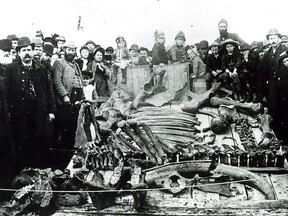In spring 1890, William Reycraft discovered some rather odd, very large bones while digging a ditch on his uncle’s farm near Highgate.

In spring 1890, William Reycraft discovered some rather odd, very large bones while digging a ditch on his uncle’s farm near Highgate. This seemingly innocent discovery seemed nothing more than a relatively interesting oddity until word spread and others began to arrive.
Advertisement 2
Article content
John Jelly and William Hillhouse from Shelburne, north of Orangeville, rushed to the Highgate farm and, for a mother $25, bought the excavation rights to what would become known as the Highgate mastodon.
Article content
The excavation team set to work and disinterred two wagon loads of large bones in one day. When Mr. Reycraft saw all the bones recovered, he offered to buy them back but was told Jelly and Hillhouse would “not sell these bones for $3,000!”
Among the bones unearthed was a lower jaw (six centimeters across) and six teeth (15 cm long and 6 cm across) in perfect condition. It was estimated the skeleton was 95 per cent intact. It was one of the largest, most complete fossilized skeleton of an extinct animal found in North America at that time.
Advertisement 3
Article content
The Toronto Globe newspaper of the day described the find as “equalling, if not surpassing, anything yet known to science.”
From 1890-92, Hillhouse and Jelly displayed the bones on a tour of sorts in Ontario, during which a tooth mysteriously disappeared in Guelph.
After 1892, Hillhouse and Jelly hired RA Essery (for $50 a month) to take the bones on tour in Western Canada. While on tour, Essery died “somewhere out West” and the Highgate Mastodon bones were mysteriously “lost.” It began a series of mysterious trails that led seemingly everywhere but back to Highgate.
A few months later, Hillhouse got a poster from his niece in Neche, ND, indicating there was a traveling exhibit matching the description of the Highgate mastodon under the management of two men named Thompson and Glover.
Advertisement 4
Article content
Sometime around 1893, the bones ended up in storage at the Bibb Corn Broom Co. in Minneapolis. Here the bones were abandoned and later sold to Harry Dickinson, who exhibited them in towns throughout Minnesota and the Dakotas from 1895-98.
In 1898 James Grassick bought the skeleton from the Dickinson Family for $10 and by 1902, it was loaned to the University of North Dakota for display.
The Highgate mastodon soon was forgotten and it was not until 1974 that the bones were rediscovered in a university storage area. By 1991, their importance was again realized and they became the feature exhibit in the fossil collection of the new North Dakota Heritage Center across from the state capitol in Bismarck.
Today, the Highgate mastodon has been painstakingly restored and put together, standing over three meters high in a manner clearly suggesting (minus the muscles, flesh and hide) what it would have looked like in life.
Advertisement 5
Article content
At the North Dakota exhibit, you’ll learn these Mammut americanums appeared about 20 million years ago and disappeared about 10,000 years ago. These forest-dwelling creatures also inhabit shallow lakes, ponds and swamps.
They were herbivores with a diet consisting of twigs, leaves and stems. They stood about three meters tall, 4.5 m long and weighed anywhere from four to six tons. Cousins of the woolly mammoth, they could endure cold climates thanks to their long, shaggy coats.
There is no question the Highgate mastodon is in good hands in North Dakota, but it’s unfortunate Chatham Kent was not able to keep its mastodon. It would certainly make a great focal point for our tourism industry today.
Article content
